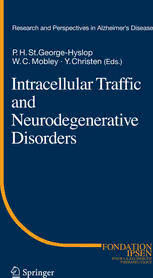
Intracellular Traffic and Neurodegenerative Disorders PDF
Preview Intracellular Traffic and Neurodegenerative Disorders
Research and Perspectives in Alzheimer’s Disease P. H.St.George-Hyslop W. C. Mobley · Y. Christen (Eds.) (cid:8)(cid:12)(cid:13)(cid:14)(cid:15)(cid:16)(cid:17)(cid:18)(cid:18)(cid:19)(cid:18)(cid:15)(cid:14)(cid:20)(cid:7)(cid:14)(cid:15)(cid:21)(cid:21)(cid:22)(cid:16)(cid:20) (cid:15)(cid:12)(cid:23) (cid:4)(cid:17)(cid:19)(cid:14)(cid:24)(cid:23)(cid:17)(cid:25)(cid:17)(cid:12)(cid:17)(cid:14)(cid:15)(cid:13)(cid:22)(cid:26)(cid:17) (cid:5)(cid:22)(cid:27)(cid:24)(cid:14)(cid:23)(cid:17)(cid:14)(cid:27) (cid:2)(cid:3)(cid:4)(cid:5)(cid:6)(cid:7)(cid:8)(cid:3)(cid:4) (cid:8)(cid:9)(cid:10)(cid:11)(cid:4) POUR LA RECHERCHE 1 23 THERAPEUTIQUE Intracellular Traffic and Neurodegenerative Disorders RESEARCH AND PERSPECTIVES IN ALZHEIMER’SDISEASE Peter H. St. George-Hyslop • William C. Mobley Yves Christen Editors Intracellular Traffic and Neurodegenerative Disorders 123 Editors Dr.PeterH.St.George-Hyslop Dr.WilliamC.Mobley DepartmentofLaboratoryMedicine DepartmentofNeurology andPathobiology StandfordUniversitySchoolofMedicine UniversityofToronto StandfordCA94305-5316 TranzNeuroscienceBldg. USA TorontoONM5S3H2 [email protected] Canada [email protected] Dr.YvesChristen FondationIPSEN PourlaRechercheThérapeutique 65,quaiGeorgesGorse 92650BoulogneBillancourt Cedex-France [email protected] ISSN0945-6066 ISBN978-3-540-87940-4 e-ISBN978-3-540-87941-1 LibraryofCongressControlNumber:2008936139 (cid:2)c 2009Springer-VerlagBerlinHeidelberg Thisworkissubjecttocopyright. Allrightsarereserved,whetherthewholeorpartofthematerialis concerned,specificallytherightsoftranslation,reprinting,reuseofillustrations,recitation,broadcasting, reproductiononmicrofilmorinanyotherway,andstorageindatabanks.Duplicationofthispublication orpartsthereofispermitted onlyundertheprovisions oftheGermanCopyrightLawofSeptember9, 1965,initscurrentversion,andpermissionforusemustalwaysbeobtainedfromSpringer.Violationsare liabletoprosecutionundertheGermanCopyrightLaw. Theuseofgeneraldescriptivenames,registerednames,trademarks,etc.inthispublicationdoesnotimply, evenintheabsenceofaspecificstatement,thatsuchnamesareexemptfromtherelevantprotectivelaws andregulationsandthereforefreeforgeneraluse. Printedonacid-freepaper springer.com Foreword Neurodegenerative disorders are common and devastating. Rationally, the most effective treatments will target pathogenetic mechanisms. While alternative ap- proaches, based on alleviating the symptoms of patients with Alzheimer disease, Parkinsondisease,Huntingtondisease,priondisordersoramyotrophiclateralscle- rosis, can be expected to reduce suffering, studies of pathogenesis of these age- relateddisorderswillbemostimportantforenablingearlydiagnosisandthecreation of preventative and curative treatments. It is in this context that a recent IPSEN meeting (The 23rd Colloque Me´decine et Recherche, April 28, 2008) focused on arolefordisruptionofintracellulartraffickinginneurodegenerativedisorders.The meetingcapturedemerginginsightsintopathogenesisfromdisruptedtraffickingand processingofproteinsimplicatedinage-relateddegeneration. Protein folding, trafficking and signaling were the principal topics covered at the meeting. Importantly,the presenters pointed to the importantlyintersection of these themes. While the proteolytic processing of APP into its toxic product, the Aβpeptide,isanintensivefocusofworkinmanylaboratories,itisonlyrelatively recentlythatinvestigatorshavebeguntoexamineindepththecellularcompartments and traffickingevents that mediate APP processing and how derangementof traf- ficking pathways could impact them. Thus, discoveries by St George-Hyslop and colleaguesthatSORL1bindsAPP,thatcertainpolymorphismsinSORL1increases theriskofAlzheimerdiseaseandthatseveralofthesepolymorphismsarepredicted tomodifySORL1 levelsso asto increaseAβ productionprovidedthe perspective that malfunctionof cellular mechanismscould play a defining role in APP-linked pathology. Willnow built on this theme by defining further the cellular pathways impactedbySORLA,whileSeamanlinkedtheseobservationswithproteinsofthe retromercomplex,forwhichearlierevidencesuggesteda linktoalteredAPPpro- cessing. ContributionsbyBeyreutherandKins and byHaass furtherinformedthe discussion by providing new insights into the proteins with which APP interacts, including its family members APLP1 and 2, and through studies of g secretase. GandyreviewedstudiesshowingthatAPPsortingandmetabolismisinformedby a numberofextracellularsignalsthatactthroughphosphorylationof APP. Impor- tantly,theparticipationoftheendosomalpathwayandearlyendosomesinparticular v vi Foreword reinforce the view that trafficking errors at this locus contribute significantly to APP-linked pathology,observationsaddressed directly by Rajendran and Simons. Sorkindetailed recentadvancesin understandingproteintraffickingand signaling in the endosomal system, studies that must now be extended to APP. But what is itaboutAPPmisprocessingthatdefineskeystepsinpathogenesis?Mostinvestiga- torsfocussquarelyonAβ,butrecentfindingssuggestthatamorerefinedfocuson APPwillbeneededtounderstandimportantsteps.Indeed,Mobleyandcolleagues, in studies of mouse models of Down syndrome, show that APP gene dose, and particularlythe levelsof its C-terminalfragments,may be more directlylinked to Alzheimer-likepathogenesisthantheleveloftheAβpeptide.Bywhatmechanisms wouldaltered traffickingmechanismsinfluencethe cell? An emergingtheme, one thatlinksstudiesofAlzheimerpathogenesistootherneurodegenerativedisorders,is thatproteinmisfoldingplaysadefiningrole.Thiswasthefocusofworkreportedby Lindquist,instudiesofParkinsonandHuntingtondiseasemodels,andMandelkow andcolleaguesinstudiesoftaumutants.Theabilityofmisfoldedproteinstodysreg- ulatecellularprocessesraisestheexcitingpossibilitythatproteinmisfoldingerrors can be defined and serve as a target of future therapeutics. In the end, it will be essentialtoexploretheeventswhosecompromiseiscriticaltoneuralcellsurvival andfunction.Oneimportantlesionmaybetheaxonaltransportoftrophicmessages. Holzbauermakesacompellingcasethatsuchmessagesaremarkedlycompromised inmodelsofamyotrophiclateralsclerosisandSaudoudocumentsdramaticchanges inBDNFtraffickinginmodelsofHuntingtondisease.Finally,Mobleyreportsdis- ruptionofNGFtransportinmodelsofDownsyndromeandAlzheimerdisease.That otherimportantretrogrademessagesmustbeexaminedissuggestedbyMartinand colleagues who document the dynamic processes that link axonal transport with synapticplasticity. Thoughitisdifficulttopredictthecourseoffuturework,themeetingsupported the view that misregulation of processing and trafficking events, especially those thatoccurin theendocyticpathway,willbeimportantfordefiningandcountering thepathogenesisofage-relatedneurodegenerativedisorders. W.Mobley P.StGeorge-Hyslop Y.Christen Acknowledgements The editors wish to thank Jacqueline Mervaillie and Sonia Le Cornec for the organizationofthemeetingandMaryLynnGagefortheeditingofthebook. vii Contents Contributors....................................................... xi AmyloidPrecursorProteinSorting andProcessing: Transmitters, Hormones,andProteinPhosphorylationMechanisms................. 1 SamGandy,OdetedaCruzeSilva,EdgardaCruzeSilva, ToshiharuSuzuki,MichelleEhrlich,andScottSmall IntramembraneProteolysisbyγ-SecretaseandSignalPeptidePeptidases 11 ReginaFluhrerandChristianHaass AxonalTransportandNeurodegenerativeDisease .................... 27 ErikaL.F.Holzbaur SimpleCellularSolutionstoComplexProblems...................... 41 SusanLindquistandKarenL.Allendoerfer TauandIntracellularTransportinNeurons ......................... 59 E.-M.Mandelkow,E.Thies,S.Konzack,andE.Mandelkow SignalingBetweenSynapseandNucleusDuringSynapticPlasticity ..... 71 Kwok-OnLai,DanWang,andKelseyC.Martin Axonal Transport of Neurotrophic Signals: An Achilles’ Heel forNeurodegeneration? .......................................... 87 AhmadSalehi,ChengbiaoWu,KeZhan,andWilliamC.Mobley MembraneTraffickingandTargetinginAlzheimer’sDisease........... 103 LawrenceRajendranandKaiSimons Huntington’s Disease: Function and Dysfunction of Huntingtin inAxonalTransport ............................................. 115 Fre´de´ricSaudouandSandrineHumbert ix x Contents TheRoleofRetromerinNeurodegenerativeDisease .................. 125 ClaireF.SkinnerandMatthewN.J.Seaman RegulationofEndocyticTraffickingofReceptorsandTransporters byUbiquitination:PossibleRoleinNeurodegenerativeDisease ......... 141 AlexanderSorkin TheSortilin-RelatedReceptorSORL1isFunctionallyandGenetically AssociatedwithAlzheimer’sDisease ............................... 157 Ekaterina Rogaeva, Yan Meng, Joseph H. Lee, Richard Mayeux, LindsayA.Farrer,andPeterStGeorge-Hyslop RegulationofTransportandProcessingofAmyloidPrecursorProtein bytheSortingReceptorSORLA................................... 167 ThomasE.Willnow,MichaelRohe,andVanessaSchmidt Index .............................................................181
